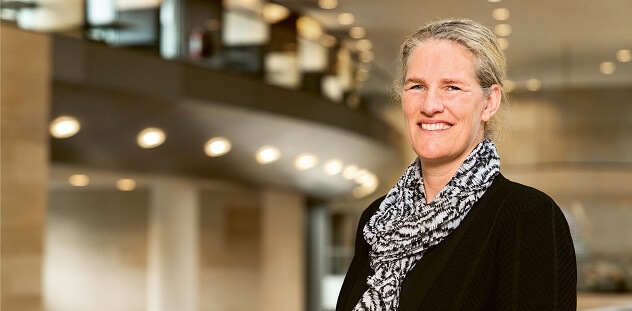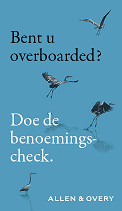Tanja Cuppen (ABN AMRO) on the Future of the CRO

29-06-2022 | Author: Jan Bletz | Image: Joke Schut
Once upon a time – almost a decade ago now – Tanja Cuppen was Chief Financial & Risk Officer of Rabobank International. Nowadays, it would be unthinkable for someone to be both Chief Risk Officer and Chief Financial Officer at a major bank: This combination is considered to be too demanding, too complex and with insufficient checks and balances. The work involved in risk management in particular has steadily expanded in recent decades. Risk used to be mainly about managing straightforward credit risks and other financial risks, but all sorts of risks have been added to that list in recent years.
In ABN AMRO's latest annual report, two of the issues that Cuppen flags up are climate risks and the risk of cybercrime. Banks are increasingly limiting risks due to stricter laws and regulations. Just think of all the rules to combat fraud and money laundering that have been imposed in recent years. ‘Risks are constantly changing and evolving, and new risks are constantly appearing – so it is better to be prepared for them,’ Cuppen writes in ABN AMRO's annual report. She says it is important to pay sustained attention to the “risk culture” within the bank. Cuppen discussed risk, governance, leadership and diversity with Marieke van Casteren, Leadership Advisory Services Consultant at Spencer Stuart.
I have one question before we talk about risk management within the bank. I often read the book Good Night Stories for Rebellious Girls by Elena Favilli to my daughter. It contains short stories about 100 women who have done something special, from Marie Curie to Serena Williams. They often turn out to have a special talent at a young age, and manage – often against the spirit of the times – to pursue that talent. When I told my daughter about this interview, she wondered how that was for you. Did you have any idea at a young age that you would play such an important role in the financial world? Were there any indications of that?
‘I had an ordinary childhood, and I do not think I had any special talents at a young age. I do believe that every person has talents and it is wonderful when you discover and pursue them. I grew up on a farm, which is where I get my love of nature from. On a farm you also learn to work together to get the job done. The idea of stewardship really appeals to me – that as a human being you have responsibilities towards nature, society, and future generations.’
In the four and a half years that you have been ABN AMRO’s CRO, that risk function has changed significantly. How have you contributed to that as a leader?
‘Risk management and compliance have become increasingly important topics, so there has been quite a bit of change in that sense. For me, change always starts with identifying the ‘why’ behind the change. We have linked the change to our purpose Banking for better, for generations to come, the key role of clients in our strategy and our role in society, including our role as gatekeeper. We operationalize this by working on cultural change, behavior and organizational change, for example by testing internal decision-making against the company values, risk attitude and compliance awareness. This therefore also affects HR policy, performance and evaluation processes, promotions, appointments – to name just a few examples.’
That sounds very logical, but it cannot have been an easy task. After all, such a major bank is like an oil tanker that does not turn easily. What challenges have you faced?
‘Change takes time. Perhaps my agricultural background helps in this respect. You do not plough, sow and harvest all on the same day. The whole process takes time. You cannot make the grass grow faster by pulling it, but you can help it grow by consistently applying fertilizer. So it is also a matter of being consistent. We have now made the transition. The process of implementing the strategy is progressing well and risk management is effectively incorporated within the bank.’
Meanwhile, more than 5,000 people at ABN AMRO are working to combat money laundering. Are the efforts to manage risks resulting in an excess of activities that puts pressure on the bank's profitability?
‘I think our gatekeeper role is very important. We need to try and fulfill that role as effectively and efficiently as possible – in other words, with fewer people. One of the ways in which we can do that is by automating more tasks. Further collaboration within the chain is also important: With other banks within the Transaction Monitoring Netherlands organization and with the Ministries of Finance and Justice, the Dutch National Police service and the Fiscal Intelligence and Investigation Service within the Financial Expertise Centre. Together, we can look into how efficiency can be promoted holistically throughout the chain.’
What does all this mean for the CRO of the future? What will be the CRO’s profile within the bank?
‘In any case, risk management will remain linked to the bank's strategy. Essentially, banking is about taking risks – that is the profession. It is mainly about credit risks. Compliance is also becoming increasingly important, and the behavioral component too.
The future CRO will also have access to much more data and models than the CRO of the past – and will need to make analyses and decisions based on that information. In short, the role of the CRO is becoming broader and has a qualitative aspect, culture and behavior, as well as that very quantitative aspect of data and models. It also remains a strategic position, for the simple reason that the consequences can be huge when something goes wrong. For that reason, the CRO will continue to have an independent role within the bank – as a second line, a counterforce that monitors the risks and ensures compliance with the laws and regulations. So I do not expect the CFO and CRO positions to be combined again within the banking industry.’
You have extensive experience in other positions in addition to CRO – especially as a supervisory director. You are now a supervisory board member at Menzis. To what extent do your roles as CRO and supervisory director reinforce each other?
‘At Menzis, I am an outsider looking in. I have no background in health insurance, which is valuable: It means you focus on different things and ask different questions than someone from within the organization. By doing so, you can prompt people to think with the goal of making better decisions. Conversely, my supervisory positions also allow me to learn a lot about other sectors. Menzis is a cooperative and develops its policies in collaboration with its members. Menzis promotes sustainable, accessible healthcare and quality of life, and that really appeals to me. Prevention is an important matter – a healthy lifestyle can also be a medicine. If you think about it, there is a nice parallel with risk management there. There too, prevention is better than cure: Damage prevention is generally more effective than detection and response.’
You began taking on supervisory roles fairly early on in your career, which is quite an achievement. Some people decide to devote all their energy to their work within their own organization, only accepting external advisory and supervisory roles at a later stage in their careers. What do you think about that?
‘Both are possible, and I do not think one is necessarily better than the other. Personally, I have been guided by my own motivations. I have a broad social commitment, and so I have always had ‘side jobs’. I also advise other executives to follow their own motives – to follow their heart. A supervisory role requires time and attention, and it helps if you have a strong connection with the company’s mission.’
Nowadays, women in particular are accepting supervisory positions early on, and they sometimes even give up their board positions shortly afterwards. What do you think about the rise of ‘early’ professional Supervisory Board members?
‘I do not really have an opinion about it. I think it is important that a Supervisory Board has a diverse, inclusive composition. A combination of directors and non-executive directors contributes to that inclusivity. It results in better supervision and, ultimately, to balanced decisions that can count on broad support.’
You’ve just touched on the issue of diversity and inclusion, which is important within the bank. A lot has changed in recent years. Almost half of the extended leadership team are already women, and in the risk management department over a third of the top positions are held by women. How have you contributed to that?
‘Obviously, this is something you all do together. It is certainly something I feel strongly about – not just in terms of gender diversity, but also cultural diversity. I try to make sure that the importance of diversity is always factored in, whether it is an appointment or something as small as an internal presentation. I always make sure that the representation is diverse.
I think inclusion is important and perhaps even more important than diversity. People should feel free to contribute their own point of view. Only then does diversity really add value. It is also easier said than done to create a climate in which people feel free to do that. I do not have any magic tricks with regard to inclusion – it is something that needs constant attention. In any case, the most important thing is that everyone feels heard. That is only possible if everyone is aware of how important it is that different perspectives are considered within the bank – even if they do not match your own ideas and biases. A diverse group ultimately makes better decisions. It sometimes takes a little longer to really understand each other. It can be difficult, especially since we like to make decisions quickly.’
How can we ensure that diversity and inclusion are promoted at the top, and how can all talented individuals continue to develop within companies?
‘As I said earlier, I believe everyone has talents that you need to discover. It is also important to develop broadly and tackle new challenges on time. You know it is time for something new when the déjà vu percentage of your job exceeds 50%. Get inspiration from others. Within the bank, we use reverse mentoring for talented individuals with culturally diverse backgrounds. Reverse mentoring is when a director spends time with a talented individual from the organization so that they can learn from each other. I also have a reverse mentor who helps me better understand her world and become aware of the impact of my decisions from her perspective. In turn, she learns what it is like to have a board position.’
What is your opinion on the gender quota?
‘I am ambivalent about that. I think you should hire someone because they are the best person for the position. On the other hand, women are still underrepresented at the top – although that has been an issue for a long time. So while I do understand why the quota is in place, deep down I am convinced that it should not be.’
This interview was published in Management Scope 06 2022.
This article was last changed on 29-06-2022

